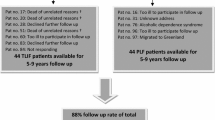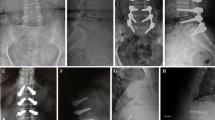Abstract
Background
Though the anterior lumbar interbody fusion with cages is an interesting option in the treatment of discogenic low back pain, cage-related complications opened the way to alternative options like circumferential fusion or recent ALIF techniques using cages and anterior instrumentation. As the latter are rather recent, the aim of this prospective study was to quantitatively evaluate the early outcomes after ALIF with anterior cage and plate construct.
Methods
Pre- and postoperative data of 41 patients (mean age 42 years) were analyzed from a clinical, socio-professional, quality of life and biomechanical point of view, with a mean follow-up of 1.8 years. Evaluation was based on clinical data, four scores (SF-12, JOA, VAS, patient satisfaction index) and several radiological parameters (describing spine geometry and balance) for an accurate outcome assessment.
Results
In 1 and 2 years follow-up exams, good and excellent outcomes were found in 92% of cases, associated with high levels of quality of life (83%) and satisfaction (95%), but also with a late return to work (40% at 1 year and 76% at 2 years). Outcome was not related to postoperative disc narrowing, observed in 15% of patients. Radiological parameters values highlighted normal spine geometry and balance in 71% of cases and were postoperatively constant in most patients.
Conclusion
From a clinical and functional point of view, the early outcomes after ALIF with cage and plate were in agreement with success ranges in the literature; they were completed by good levels of quality of life and patient’s satisfaction. In addition to subsidence detection, biomechanical analysis offered a detailed insight into the evolution of the treated segment and on its impact on spine’s stability and balance.
Résumé
Contexte
L’arthrodèse lombaire intersomatique antérieure (ALIA) avec cages représente une option intéressante dans le traitement des lombalgies discogéniques; toutefois, les complications liées aux cages ont conduit au développement des options alternatives comme la fusion circonférentielle ou des techniques récentes d’ALIA avec cages et instrumentation antérieure. Les dernières techniques étant relativement récentes, l’objectif de notre étude prospective a été une évaluation quantitative des résultats après ALIA avec cage et plaque antérieure.
Méthodes
Les données pré- et postopératoires de 41 patients (âge moyen 42 ans) ont été analysées d’un point de vue clinique, socioprofessionnel, qualité de vie et biomécanique, avec un recul moyen de 1.8 ans. Afin d’obtenir une évaluation précise des résultats, notre analyse a été basée sur les données cliniques, quatre scores (SF-12, JOA, EVA, indice de satisfaction) et plusieurs paramètres radiologiques (décrivant la géométrie et l’équilibre du rachis).
Résultats
A court et moyen terme, les résultats ont été bons et excellents dans 92% des cas, associés à des bons niveaux de qualité de vie (83%) et de satisfaction (95%), mais aussi à un retour au travail tardif (40% à 1 an et 76% à 2 ans). Le résultat final ne semble pas lié au rétrécissement postopératoire de l’espace discal, observé dans 15% de patients. Les paramètres radiologiques, quasi-constants en postopératoire pour la plupart des cas, ont mis en évidence une géométrie et un équilibre rachidien normaux dans 71% des cas.
Conclusion
D’un point de vue clinique et fonctionnel, les résultats préliminaires de l’ALIA avec cage et plaque sont comparables aux taux de succès de la littérature; ils sont complétés par de bons niveaux de qualité de vie et de satisfaction du patient. Outre la détection de la subsidence, l’analyse biomécanique offre une vue détaillée sur l’évolution du segment traité et son impact sur la stabilité et l’équilibre du rachis entier.




Similar content being viewed by others
References
Beutler WJ, Peppelman WC Jr (2003) Anterior lumbar fusion with paired BAK standard and paired BAK Proximity cages: subsidence incidence, subsidence factors, and clinical outcome. Spine J 3:289–293
Blumenthal SL, Ohnmeiss DD (2003) Intervertebral cages for degenerative spinal diseases. Spine J 3:301–309
Burkus JK, Gornet MF, Dickman CA, Zdeblick TA (2002) Anterior lumbar interbody fusion using rhBMP-2 with tapered interbody cages. J Spinal Disord Tech 15:337–349
Champain S, Benchikh K, Nogier A, Mazel C, Guise JD, Skalli W (2006) Validation of new clinical quantitative analysis software applicable in spine orthopaedic studies. Eur Spine J 15:982–991
Cheung KM, Zhang YG, Lu DS, Luk KD, Leong JC (2003) Reduction of disc space distraction after anterior lumbar interbody fusion with autologous iliac crest graft. Spine 28:1385–1389
Choi JY, Sung KH (2006) Subsidence after anterior lumbar interbody fusion using paired stand-alone rectangular cages. Eur Spine J 15:16–22
Chung SK, Lee SH, Lim SR, Kim DY, Jang JS, Nam KS, Lee HY (2003) Comparative study of laparoscopic L5-S1 fusion versus open mini-ALIF, with a minimum 2-year follow-up. Eur Spine J 12:613–617
Daltroy LH, Cats-Baril WL, Katz JN, Fossel AH, Liang MH (1996) The North American spine society lumbar spine outcome assessment instrument: reliability and validity tests. Spine 21:741–749
Dennis S, Watkins R, Landaker S, Dillin W, Springer D (1989) Comparison of disc space heights after anterior lumbar interbody fusion. Spine 14:876–878
Dunlop RB, Adams MA, Hutton WC (1984) Disc space narrowing and the lumbar facet joints. J Bone Joint Surg Br 66:706–710
Evans JH (1985) Biomechanics of lumbar fusion. Clin Orthop Relat Res:38–46
Fiere V, Mulsant P (2003) Retrospective study of 80 cases of anterior lumbar interbody fusion with combined PEEK Cages and an Anterior Specific Plate. In: Proceedings of the 5th international disc cage and prosthesis meeting, Lenzerheide
Fraser RD (1995) Interbody, posterior, and combined lumbar fusions. Spine 20:167S–177S
Frobin W, Brinckmann P, Biggemann M, Tillotson M, Burton K (1997) Precision measurement of disc height, vertebral height and sagittal plane displacement from lateral radiographic views of the lumbar spine. Clin Biomech (Bristol, Avon) 12(suppl 1):S1–S63
Gandek B, Ware JE, Aaronson NK, Apolone G, Bjorner JB, Brazier JE, Bullinger M, Kaasa S, Leplege A, Prieto L, Sullivan M (1998) Cross-validation of item selection and scoring for the SF-12 Health Survey in nine countries: results from the IQOLA Project. International quality of life assessment. J Clin Epidemiol 51:1171–1178
Gerber M, Crawford NR, Chamberlain RH, Fifield MS, LeHuec JC, Dickman CA (2006) Biomechanical assessment of anterior lumbar interbody fusion with an anterior lumbosacral fixation screw-plate: comparison to stand-alone anterior lumbar interbody fusion and anterior lumbar interbody fusion with pedicle screws in an unstable human cadaver model. Spine 31:762–768
Inoue S, Watanabe T, Hirose A, Tanaka T, Matsui N, Saegusa O, Sho E (1984) Anterior discectomy and interbody fusion for lumbar disc herniation. A review of 350 cases. Clin Orthop Relat Res (183):22–31
Jackson RP, McManus AC (1994) Radiographic analysis of sagittal plane alignment and balance in standing volunteers and patients with low back pain matched for age, sex, and size. A prospective controlled clinical study. Spine 19:1611–1618
Kumar A, Kozak JA, Doherty BJ, Dickson JH (1993) Interspace distraction and graft subsidence after anterior lumbar fusion with femoral strut allograft. Spine 18:2393–2400
Kuslich SD, Ulstrom CL, Griffith SL, Ahern JW, Dowdle JD (1998) The Bagby and Kuslich method of lumbar interbody fusion. History, techniques, and 2-year follow-up results of a United States prospective, multicenter trial. Spine 23:1267–1278 (discussion 1279)
Lee SH, Choi WG, Lim SR, Kang HY, Shin SW (2004) Minimally invasive anterior lumbar interbody fusion followed by percutaneous pedicle screw fixation for isthmic spondylolisthesis. Spine J 4:644–649
Legaye J, Duval-Beaupere G, Hecquet J, Marty C (1998) Pelvic incidence: a fundamental pelvic parameter for three-dimensional regulation of spinal sagittal curves. Eur Spine J 7:99–103
Madan SS, Boeree NR (2003) Comparison of instrumented anterior interbody fusion with instrumented circumferential lumbar fusion. Eur Spine J 12:567–575
Madan SS, Harley JM, Boeree NR (2003) Anterior lumbar interbody fusion: does stable anterior fixation matter? Eur Spine J 12:386–392
Mayer HM (1997) A new microsurgical technique for minimally invasive anterior lumbar interbody fusion. Spine 22:691–699 (discussion 700)
Nachemson A, Zdeblick TA, O’Brien JP (1996) Lumbar disc disease with discogenic pain. What surgical treatment is most effective? Spine 21:1835–1838
Natarajan RN, Andersson GB (1999) The influence of lumbar disc height and cross-sectional area on the mechanical response of the disc to physiologic loading. Spine 24:1873–1881
Newman MH, Grinstead GL (1992) Anterior lumbar interbody fusion for internal disc disruption. Spine 17:831–833
Oxland TR, Lund T (2000) Biomechanics of stand-alone cages and cages in combination with posterior fixation: a literature review. Eur Spine J 9(suppl 1):S95–S101
Penta M, Fraser RD (1997) Anterior lumbar interbody fusion. A minimum 10-year follow-up. Spine 22:2429–2434
Rao RD, David KS, Wang M (2005) Biomechanical changes at adjacent segments following anterior lumbar interbody fusion using tapered cages. Spine 30:2772–2776
Regan JJ, Aronoff RJ, Ohnmeiss DD, Sengupta DK (1999) Laparoscopic approach to L4-L5 for interbody fusion using BAK cages: experience in the first 58 cases. Spine 24:2171–2174
Thalgott JS, Klezl Z, Timlin M, Giuffre JM (2002) Anterior lumbar interbody fusion with processed sea coral (coralline hydroxyapatite) as part of a circumferential fusion. Spine 27:E518–525 (discussion E526–517)
Tiusanen H, Seitsalo S, Osterman K, Soini J (1996) Anterior interbody lumbar fusion in severe low back pain. Clin Orthop Relat Res (324):153–163
Tsantrizos A, Andreou A, Aebi M, Steffen T (2000) Biomechanical stability of five stand-alone anterior lumbar interbody fusion constructs. Eur Spine J 9:14–22
Turner JA, Ersek M, Herron L, Haselkorn J, Kent D, Ciol MA, Deyo R (1992) Patient outcomes after lumbar spinal fusions. Jama 268:907–911
Vazquez RM, Gireesan GT (2003) Balloon-assisted endoscopic retroperitoneal gasless (BERG) technique for anterior lumbar interbody fusion (ALIF). Surg Endosc 17:268–272
Vialle R, Levassor N, Rillardon L, Templier A, Skalli W, Guigui P (2005) Radiographic analysis of the sagittal alignment and balance of the spine in asymptomatic subjects. J Bone Joint Surg Am 87:260–267
Vishteh AG, Crawford NR, Chamberlain RH, Thramann JJ, Park SC, Craigo JB, Sonntag VK, Dickman CA (2005) Biomechanical comparison of anterior versus posterior lumbar threaded interbody fusion cages. Spine 30:302–310
Ware J, Kosinski M, Turner-Bowker D et al (2002) How to score version 2 of the SF-12® Health Survey, Lincoln, RI, Qualimetric Inc., ISBN 1-891810-10-3
Weber J, Vieweg U (2006) Anterior lumbar interbody fusion (ALIF) using a cage with stabilization. Z Orthop Ihre Grenzgeb 144:40–45
Yone K, Sakou T, Kawauchi Y, Yamaguchi M, Yanase M (1996) Indication of fusion for lumbar spinal stenosis in elderly patients and its significance. Spine 21:242–248
Yorimitsu E, Chiba K, Toyama Y, Hirabayashi K (2001) Long-term outcomes of standard discectomy for lumbar disc herniation: a follow-up study of more than 10 years. Spine 26:652–657
Zanoli G, Stromqvist B, Jonsson B (2001) Visual analog scales for interpretation of back and leg pain intensity in patients operated for degenerative lumbar spine disorders. Spine 26:2375–2380
Zdeblick TA, David SM (2000) A prospective comparison of surgical approach for anterior L4-L5 fusion: laparoscopic versus mini anterior lumbar interbody fusion. Spine 25:2682–2687
Acknowledgments
The authors wish to thank Maindron V, Mulsant P and Plantier S for their precious help in data collection and SpineNetwork for their support (grant for a PhD project ruled by the National Agency for Technological Research (ANRT in French): CIFRE no. 677/2002).
Author information
Authors and Affiliations
Corresponding author
Appendices
Appendix 1
Table 4
Appendix 2
Table 5
Rights and permissions
About this article
Cite this article
Champain, S., Fière, V., Mitulescu, A. et al. Early outcomes after ALIF with cage and plate in discogenic low back pain: a quantitative analysis. Eur J Orthop Surg Traumatol 18, 177–188 (2008). https://doi.org/10.1007/s00590-007-0283-4
Received:
Accepted:
Published:
Issue Date:
DOI: https://doi.org/10.1007/s00590-007-0283-4




